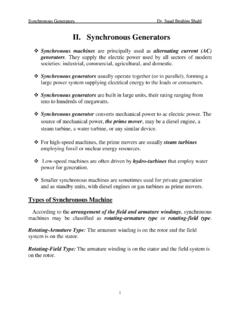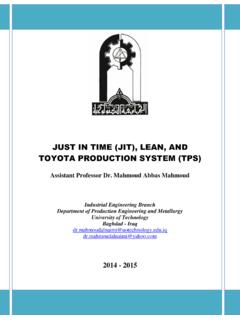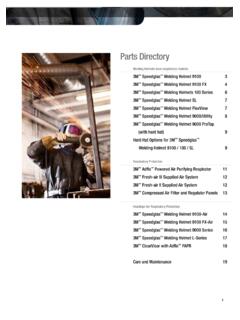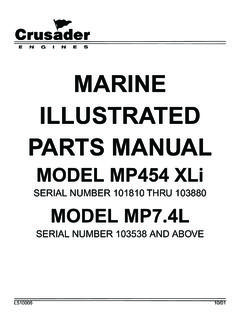Transcription of Mechanical Drawing (Assembly Drawing) Second Stage
1 - 0 - Republic of Iraq Ministry of Higher Education and Scientific Research University of Technology Department of Production Engineering and Metallurgy Production Engineering Mechanical Drawing (Assembly Drawing ) Second Stage Asst. Prof. Dr. Shukry H. Aghdeab Baqer Ayad Ahmed Mohammed Sattar Jabbar Eng. Emad Aziz Hamdi 2016 1437 - 1 - INTRODUCTION language General A technical person can use the graphic language as powerful means of communication with others for conveying ideas on technical matters. However, for effective exchange of ideas with others, the engineer must have proficiency in (i) language, both written and oral, (ii) symbols associated with basic sciences and (iii) the graphic language. Engineering Drawing is a suitable graphic language from which any trained person can visualize the required object.
2 As an engineering Drawing displays the exact picture of an object, it obviously conveys the same ideas to every trained eye. Irrespective of language barriers, the drawings can be effectively used in other countries, in addition to the country where they are prepared. Thus, the engineering Drawing is the universal language of all engineers. Importance of graphic language The graphic language had its existence when it became necessary to build new structures and create new machines or the like, in addition to representing the existing ones. In the absence of graphic language, the ideas on technical matters have to be conveyed by speech or writing, both are unreliable and difficult to understand by the shop floor people for manufacturing. This method involves not only lot of time and labour, but also manufacturing errors.
3 Without engineering Drawing , it would have been impossible to produce objects such as aircrafts, automobiles, locomotives, etc., each requiring thousands of different components. - 2 - Need for correct Drawing The drawings prepared by any technical person must be clear, unmistakable in meaning and there should not be any scope for more than one interpretation, or else litigation may arise. In a number of dealings with contracts, the Drawing is an official document and the success or failure of a structure depends on the clarity of details provided on the Drawing . Thus, the drawings should not give any scope for misinterpretation even by accident. It would not have been possible to produce the machines and automobiles on a mass scale where a number of assemblies and sub-assemblies are involved, without clear, correct and accurate drawings.
4 To achieve this, the technical person must gain a thorough knowledge of both the principles and conventional practice of draughting. If these are not achieved and or practiced, the drawings prepared by one may convey different meaning to others, causing unnecessary delays and expenses in production shops. Hence, an engineer should posses good knowledge, not only in preparing a correct Drawing but also to read the Drawing correctly. The course content of this sketchbook is expected to meet these requirements. The study of machine part Drawing mainly involves learning to sketch machine parts and to make working and assembly drawings. This involves a study of those conventions in drawings that are widely adopted in engineering practice. - 3 - Classification of Drawings Machine Drawing It is pertaining to machine parts or components.
5 It is presented through a number of orthographic views, so that the size and shape of the component is fully understood. part drawings and assembly drawings belong to this classification. An example of a machine Drawing is given in Fig. Production Drawing A production Drawing , also referred to as working Drawing , should furnish all the dimensions, limits and special finishing processes such as heat treatment, honing, lapping, surface finish, etc., to guide the craftsman on the shop floor in producing the component. The title should also mention the material used for the product, number of parts required Fig. Machine Drawing . - 4 - for the assembled unit, etc. Since a craftsman will ordinarily make one component at a time, it is advisable to prepare the production Drawing of each component on a separate sheet.
6 However, in some cases the drawings of related components may be given on the same sheet. Fig. represents an example of a production Drawing . Assembly Drawing A Drawing that shows the various parts of a machine in their correct working locations is an assembly Drawing as shown in fig. are several types of such drawings. Fig. Production Drawing . - 5 - Design Assembly Drawing When a machine is designed, an assembly Drawing or a design layout is first drawn to clearly visualise the performance, shape and clearances of various parts comprising the machine. Detailed Assembly Drawing It is usually made for simple machines, comprising of a relatively smaller number of simple parts. All the dimensions and information necessary for the construction of such parts and for the assembly of the Fig.
7 Assembly Drawing . - 6 - parts are given directly on the assembly Drawing . Separate views of specific parts in enlargements, showing the fitting of parts together, may also be drawn in addition to the regular assembly Drawing . Sub- Assembly Drawing Many assemblies such as an automobile, lathe, etc., are assembled with many pre-assembled components as well as individual parts. These pre-assembled units are known as sub-assemblies. A sub-assembly Drawing is an assembly Drawing of a group of related parts, that form a part in a more complicated machine. Examples of such drawings are: lathe tail-stock, diesel engine fuel pump, carburettor, etc. Installation Assembly Drawing On this Drawing , the location and dimensions of few important parts and overall dimensions of the assembled unit are indicated. This Drawing provides useful information for assembling the machine, as this Drawing reveals all parts of a machine in their correct working position.
8 Assembly Drawings for catalogues Special assembly drawings are prepared for company catalogues. These drawings show only the pertinent details and dimensions that would interest the potential buyer. Fig. shows a typical catalogue Drawing , showing the overall and principal dimensions. - 7 - Assembly Drawings for instruction manuals These drawings in the form of assembly drawings, are to be used when a machine, shipped away in assembled condition, is knocked down in order to check all the parts before reassembly and installation elsewhere. These drawings have each component numbered on the job. shows a typical example of such a Drawing . Fig. Catalogue Drawing . - 8 - Speed change lever (1) Selector switch (10) Depth adjusting knob (2) Forward switch (11) Mech.
9 Feed engagement lever (3) Pilot lamp (12) Hand free lever (4) Feed disengagement push button (13) Feed change knob (5) Start push button (14) Switch for tapping(6) Emergency stop (15) Gear shifting lever (7) Elevating handle (16) Main switch(8) Clamping handle(17) Lamp switch(9) Supply inlet (18) Fig. Assembly Drawing for instruction manuals. - 9 - exploded Assembly Drawing In some cases, exploded pictorial views are supplied to meet instruction manual requirements. These drawings generally find a place in the parts list section of a company instruction manual. Fig shows drawings of this type which may be easily understood even by those with less experience in the reading of drawings; because in these exploded views, the parts are positioned in the sequence of assembly, but separated from each other.
10 Fig. exploded assembly Drawing . - 10 - Schematic Assembly Drawing It is very difficult to understand the operating principles of complicated machinery, merely from the assembly drawings. Schematic representation of the unit facilitates easy understanding of its operating principle. It is a simplified illustration of the machine or of a system, replacing all the elements, by their respective conventional representations. Fig shows the schematic representation of a gearing diagram. Machine Shop Drawing Rough castings and forgings are sent to the machine shop for finishing operation (Fig. ). Since the machinist is not interested in the dimensions and information of the previous stages, a machine shop Fig. Schematic assembly Drawing . 1 Shaft 10 2 Change over lever 9 2 Disk clutch 8 2 Worm wheel 7 2 Worm 6 2 Shoe brake 5 3 Heming bone gear 4 6 Bearing 3 2 Elastic coupling 2 2 Electric motor 1 Qty Name No.















